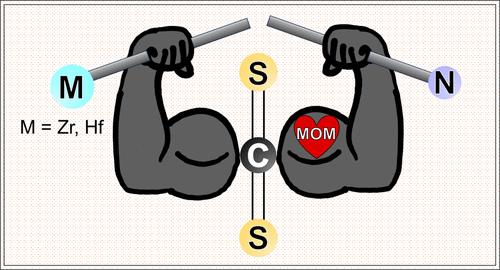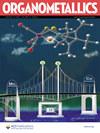通过插入 CS2 生成同色锆和铪二硫代氨基甲酸酯:断键和命名
IF 2.5
3区 化学
Q2 CHEMISTRY, INORGANIC & NUCLEAR
引用次数: 0
摘要
研究人员通过二硫化碳插入锆和铪酰胺来合成同孔锆和铪二硫代氨基甲酸盐,以了解它们作为可溶性分子前驱体在铬化过磷酸盐和二元金属硫化物中的用途。用 CS2 处理 M(NEtR)4(M = Zr、Hf,R = Me、Et)可定量生成同色的第 IV 组二硫代氨基甲酸盐。对 Zr(κ2-S2CNMeEt) (1)、Zr(κ2-S2CNEt2)4 (2) 和 Hf(κ2-S2CNEt2)4 (4) 进行了表征。计算分析证实了红外光谱的分配。为了说明第 IV 族二硫代氨基甲酸酯的用途,我们进行了溶液相纳米粒子合成,通过 Zr(S2CNMeEt)4 的热分解获得了 ZrS3。本文章由计算机程序翻译,如有差异,请以英文原文为准。

Formation of Homoleptic Zirconium and Hafnium Dithiocarbamates via Insertion of CS2: Breaking Bonds and Taking Names
Syntheses of homoleptic zirconium and hafnium dithiocarbamates via carbon disulfide insertion into zirconium and hafnium amides were investigated for their utility as soluble molecular precursors for chalcogenide perovskites and binary metal sulfides. Treating M(NEtR)4 (M = Zr, Hf and R = Me, Et) with CS2 resulted in quantitative yields of homoleptic Group IV dithiocarbamates. Zr(κ2-S2CNMeEt) (1), Zr(κ2-S2CNEt2)4 (2), and Hf(κ2-S2CNEt2)4 (4), a rare example of a crystal of a homoleptic hafnium CS2-inserted amide species, were characterized. Computational analysis confirmed the assignments for IR spectroscopy. To exemplify the utility of the Group IV dithiocarbamates, a solution-phase nanoparticle synthesis was performed to obtain ZrS3 via the thermal decomposition of Zr(S2CNMeEt)4.
求助全文
通过发布文献求助,成功后即可免费获取论文全文。
去求助
来源期刊

Organometallics
化学-无机化学与核化学
CiteScore
5.60
自引率
7.10%
发文量
382
审稿时长
1.7 months
期刊介绍:
Organometallics is the flagship journal of organometallic chemistry and records progress in one of the most active fields of science, bridging organic and inorganic chemistry. The journal publishes Articles, Communications, Reviews, and Tutorials (instructional overviews) that depict research on the synthesis, structure, bonding, chemical reactivity, and reaction mechanisms for a variety of applications, including catalyst design and catalytic processes; main-group, transition-metal, and lanthanide and actinide metal chemistry; synthetic aspects of polymer science and materials science; and bioorganometallic chemistry.
 求助内容:
求助内容: 应助结果提醒方式:
应助结果提醒方式:


